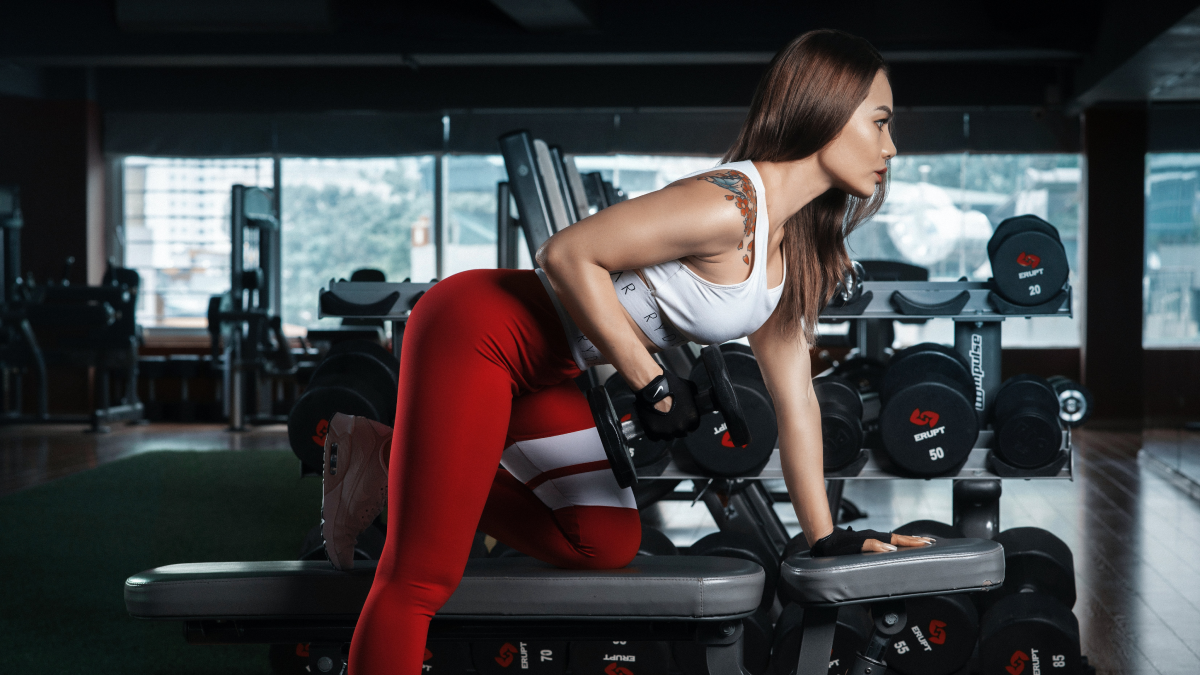
If you’re trying to get in better shape, it’s natural to wonder which are the most effective exercises for weight loss and toning up. Should you be prioritizing cardio, weight lifting, or HIIT training? We decided to get an expert’s opinion and spoke to health and fitness influencer Joanna Soh. As a successful personal trainer and nutrition coach with 2.5 million YouTube subscribers, Joanna Soh has lots of great tips on how to structure your exercise regimen for best results.
Cardio, Weight Lifting, or HIIT?
Before we get to Soh’s expert advice on the most effective exercises, let’s discuss what each type of exercise entails:
Cardio or cardiovascular exercise are typically aerobics exercises that are high-endurance such as endurance running, cycling, hiking, swimming, or kickboxing. In cardio, your heart is pumping, breathing is heavy, and you’re typically fighting fatigue while you work on endurance. You’re staying active for a prolonged period of time, which is great for your lung health. Cardio exercise is also very healthy for your heart, body, physique and brain.
Weight Lifting is a form of strength training that focuses on muscular strength. It’s an anaerobic exercise that builds muscle, sculps the body’s shape, and tones the body. Most fitness experts agree that while cardio can burn more fat, weight lifting is better for toning, shaping and sculpting the body.
HIIT stands for High-Intensity Interval Training. HIIT is a form of interval training, which means it’s cardio exercise alternated with short periods of intense anaerobic exercise (such as weight lifting) with very short resting periods until you’re too exhausted to continue. Your short bursts of intense exercise in HIIT require an explosive power that you unleash for a short duration until it’s time to switch to a lower-intensity exercise on the circuit such as squats or weight-lifting. Joanna Soh loves HIIT workouts because she notices better results when she incorporates some HIIT workouts into her routine.
“Many of us have a goal to lose weight and develop more lean muscle mass, in order to appear more toned and sculpted,” says Soh. “The question then becomes, which types of exercises should be the primary focus to get results? Cardio, weight lifting, HIIT, or a combination?”
Aim for Variety and a Balance Between Different Types of Exercises

Fitness expert Joanna Soh’s advice is, “We should always aim for a balance between different types of training.”
Everyone is different when it comes to muscular strength and natural muscular abilities. In fact, one’s muscular ability can be categorized into three muscular types:
- Strength
- Power
- Endurance
Soh’s advice is also to learn about your genetic predispositions when it comes to fitness. Your genetics predetermine where your strengths lie, in terms of your natural abilities and the most effective exercises for you. For example, your DNA can predetermine whether you’re more likely to have higher endurance, power or strength.
Optimise Your Fitness Training Program According to Your Genetic Profile
A recent study found that those who matched their training program to their genetic predispositions physically improved almost three times better than those on mismatched programs.
Matching your workout routine to your personalized strengths indicated on your genetic profile can yield better results. You can therefore optimize your training program to suit your body and your natural strengths.
Joanna Soh reveals, “I did my DNA test with CircleDNA, and it helped me discover not only my sports and fitness profile based on my genes but also the most suitable diet based on my body type.”
People are loving the CircleDNA Premium test because, with it, you receive over 500 reports in over 20 categories. Some of the personalized reports you’ll receive are about diet, nutrition, sports, fitness, skin, stress, sleep, health risks and more.
Soh explains that one of the first things you should understand, is the difference between muscular strength, power and endurance.
The Difference Between Muscular Strength, Power, and Endurance

Joanna Soh found it helpful to find out, through her DNA test, where her strengths lie. As a reminder:
Muscular Strength is one’s ability to exert maximal force against resistance.
Muscular Power is the ability to exert your force in the shortest period of time.
Endurance is the ability to exert submaximal force against resistance for an extended period of time.
As Soh explains, “Your CircleDNA personalized report will inform you of your natural abilities for all three of these: Strength, power and endurance. For example, my CircleDNA results indicated that I have low strength, medium power, and high endurance. Everyone’s combination will be unique.”
Some of you might have a genetic tendency towards high strength, high power, but low endurance. Whatever your combination of strengths is, this is referred to as your “optimal training type” based on your DNA. This is extremely helpful information to know because you can adjust your training program accordingly and see results faster.
What’s Your Optimal Training Type?
What type of fitness regimen does your body type respond best to? If you have high muscular strength, this means you can lift heavier weights. Your body will therefore likely respond well to a training program that places a higher priority on strength, such as bodybuilding.
If you have high muscular power, that means your body responds better to exercises that require more explosive power with high intensity, yet short duration. The types of exercises that suit you best are exercises such as boxing, sprinting, or high jumps.
If you have high muscular endurance, this means your muscles are designed for repetitive motions. Your body can likely handle high-repetition weight training or longer duration cardio sessions. Your body will be suited for aerobic exercises such as running, cycling, hiking or triathlons. High endurance means you can exert yourself for long periods of time and remain active for long durations.
Muscular Abilities in Popular Sports and Fitness Activities

Most of the time, there will be a cross between the muscular abilities required in sports, exercises and activities. You’ll find most of these activities require a combination of strengths, not just one.
Fitness activities that require both strength and power include activities such as powerlifting, gymnastics, wrestling and rock climbing.
Activities that require power and endurance include soccer, basketball, badminton, and boxing. A soccer player, for example, needs endurance for all the running involved in the game. Scoring a goal or passing to another player, requires power to send that ball flying.
The combination of strength and endurance is used in fitness activities such as acrobatics, rugby, ice hockey, and rowing. In rowing, for example, strength is needed to row (especially through currents) and endurance is needed to handle the repetitive motions for a long duration of time.
The ability to excel in certain sports and activities might require a greater proportion of one specific type of muscular ability. Most popular sports require all three abilities. This means that the world’s top athletes typically have excellent strength, power and endurance. Whether it’s ingrained in their DNA or achieved through training, top athletes pride themselves on their excellence within all three types of muscular abilities. Based on their DNA, (for example, a top athlete’s genetic predisposition to have high endurance) each athlete will choose a speciality sport or activity that takes full advantage of their body’s natural gifts.
How We Respond to Different Types of Exercise is Influenced by Genetics
Your genetic profile could explain why your body responds better to certain types of exercise. That’s why your CircleDNA test results could help you better personalize your exercise program, leading to the most effective exercises to get results.
Should you avoid fitness activities that require muscular abilities your body isn’t as strong in? Joanna Soh says, “No!” Soh goes on to explain, “If you look at my CircleDNA sports profile, I am prone to have high endurance, low strength, and medium power. That doesn’t mean that I should only be a runner, because of my high endurance and lesser abilities in strength and power. The truth is that if I were to put extra effort into training my endurance, I would excel quicker and better compared to if I focused on explosive, power-based workouts. The fact that I naturally have high endurance and low strength, however, does not mean that I should not be doing weight lifting or HIIT workouts. In fact, I make sure to add weight lifting and HIIT workouts into my exercise routine.”
Manipulating Your Training Strategy to Suit Your Goals

Joanna Soh explains that there are three different types of strength training that you can do at the gym, outdoors or at home. These include:
- Strength Endurance Workouts
- Maximal Strength Workouts
- Explosive Strength Workouts
For strength endurance workouts, the weight intensity would be moderate, and you’d lift 15 – 20 repetitions per set. The workout tempo or pace would be slow to moderate. The rest time between sets would be quite short, only 30 – 60 seconds of rest. 3 – 4 sets would be repeated during the workout.
During maximal strength workouts, you would lift much heavier weights. With these heavier weights, you’d lift only 6 – 12 repetitions per set. Your workout tempo could be slow to fast. Because you’re lifting heavier weights in maximal strength workout routines, your body will need longer rest periods to recover. Your rest time in between sets will be approximately 1.5 – 3 minutes. You’ll want to aim to complete 3 – 4 sets per workout.
As for explosive strength workouts or HIIT workouts, you’ll mainly be using your own bodyweight or light weights. The goal in explosive strength workouts is to complete as many reps as possible, within a predetermined time frame of typically 30 – 45 seconds. The workout pace or tempo, therefore, is as fast as possible. During this fast and explosive set, you’ll be completing as many reps as possible, without compromising your form. Your goal should be to complete 3 – 4 circuits like this, with minimal resting periods between each circuit. This is what a HIIT workout looks like.
Workout Smart, Not Hard
Manipulating your training strategy will help you determine if your training is working best when it’s focusing on strength, power, or endurance. This also helps you keep track of areas you might be weaker in, and therefore need to practice more.
Joanna Soh shares her personalized training schedule by explaining, “I schedule a strength endurance workout 3 times per week, and I aim to complete maximal strength and explosive strength workouts at least once per week. Wednesdays and Sundays are typically my rest days.”
If you’re getting a really good workout 5 – 6 times per week, it’s completely fine to take 1 – 2 days off to rest.
A Comprehensive Training Program Should Include Endurance Cardio, Weight-Lifting, and HIIT Workouts
A comprehensive training program with the best shot at success should include strength, power, and endurance workouts. A balance of all three elements (strength, power, and endurance) will be included in the most effective exercises. Sure, going for a run several times per week is great, and cardio is very important. However, you can tone your body better when you include weightlifting and HIIT each week as well.
Joanna Soh’s DNA test revealed that she has high endurance. Hence, the majority of her training program involves cardio and other aerobic exercises that require her natural endurance skills. However, as she explained, she also incorporates weight-lifting, HIIT, and other strength and power workouts into her routine.
To find out more about your body type and which types of sports and exercises you’re likely to perform better in, check out the CircleDNA Premium test.







Comments are closed.